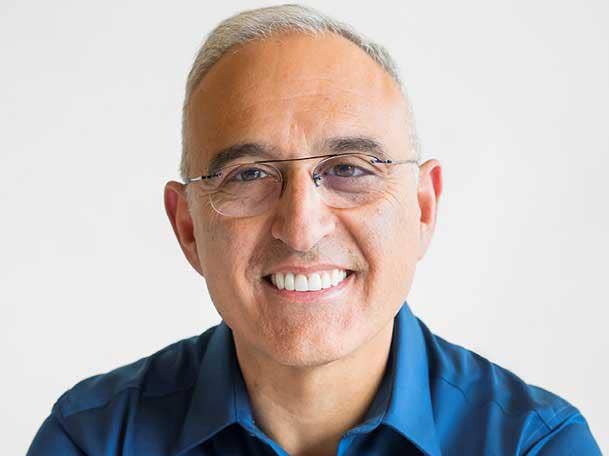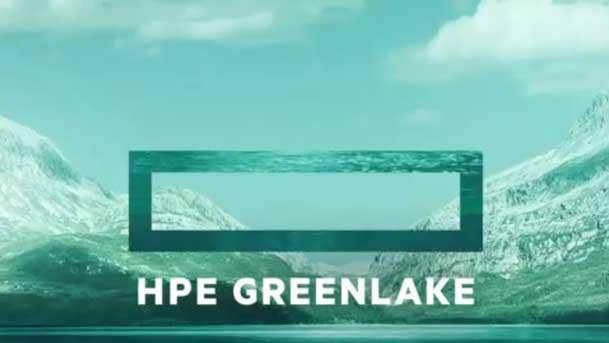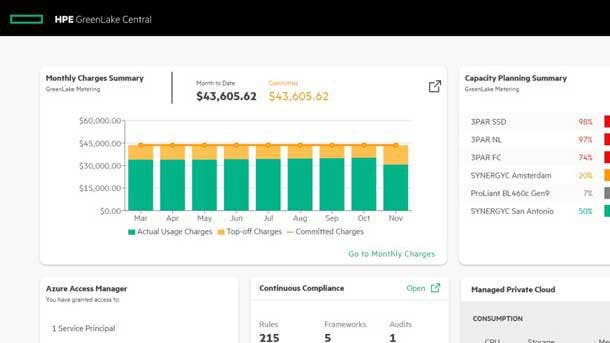HPE CEO Neri: HPE GreenLake Generating ‘Record-Breaking Demand With Impressive Profitability’
‘The success and momentum we have seen in the market makes me more committed than ever to our edge-to-cloud vision as it directly addresses evolving customer needs and positions us to deliver long-term sustainable profitable growth,’ said HPE President and CEO Anthony Neri during HPE’s annual shareholders meeting.

Building The Future
Hewlett Packard Enterprise is on a roll. HPE ended its most recent fiscal quarter, its first fiscal quarter 2022, on Jan. 31 with order growth up 20 percent, as-a-service orders up 136 percent, revenue up 2 percent over the same period last year, and an increased fiscal 2022 earnings guidance.
HPE President and CEO Antonio Neri Tuesday gave his keynote at the company’s annual shareholders meeting during which he touted the advancements the company has made in the past year, particularly in its HPE GreenLake as-a-service platform, which is at the center of the company’s technology focus and of customers’ digital transformation requirements.
“HPE GreenLake is uniquely designed to help customers drive their digital transformations through a data-first modernization approach by harnessing the power of the data,” Neri said. “As enterprises increasingly adopt hybrid multi-cloud strategies, HPE is leading a new edge-to-cloud category to enable customers to derive value from all their data, no matter where it lives.”
Neri went beyond the technology side of HPE to look at other issues impacting the company and the IT industry, including Russia’s war in Ukraine, supply chain shortages, and HPE’s strategies around R&D and environmental, social and governance (ESG) initiatives. Here are highlights of his keynote.

What’s Driving HPE’s Business
[There are] mega trends that are shaping enterprise technology. First is the explosion of connected devices and things at the edge generating an enormous amount of data. Second is the need for a cloud experience everywhere. Third, persistent data growth creates a need for more insights and an urgency to extract them.
Cutting across these trends is the shift in how enterprises want to consume technology increasingly through a flexible as-a-service consumption model. The pandemic has created a new and different world that has accelerated these trends. Customers now need to connect and engage in different ways, and technology plays a critical role in improving the health of our communities and digitizing our economy as it recovers and evolves. We have positioned HPE at the center of these trends with our edge-to-cloud platform, HPE GreenLake. HPE GreenLake is uniquely designed to help customers drive their digital transformations through a data-first modernization approach by harnessing the power of the data. As enterprises increasingly adopt hybrid multi-cloud strategies, HPE is leading a new edge-to-cloud category to enable customers to derive value from all their data, no matter where it lives.
Over the last few years, we have made tremendous progress in realizing our vision to be the edge-to-cloud company. In 2018, we said that the edge will be the next frontier, and we backed that vision with a commitment to invest $4 billion over the course of four years in our edge business. The next year, in 2019, we announced that we’ll make all our offerings available as a service within the next three years. Today, those strategic decisions and others are paying off. You are seeing our differentiated edge-to-cloud strategy yield greater returns while positioning our company for the future and delivering sustainable profitable growth for our shareholders.

Driving Toward Recurring Revenue
Our drive to higher recurring revenue streams has been intentional.
Our annualized revenue run rate, or ARR, in Q4 ’21 rose 36 percent from the prior-year period. We view this as a long-term value driver, and we expect our ARR will grow between 35 [percent] and 45 percent and exceed $2.3 billion by the end of fiscal year ’24. We are nearing the end of a cost optimization and prioritization plan we started in 2020, which will allow HPE to deliver more than $800 million in net annualized run rate savings. Our mix of unique assets, strategic investments, and execution of the cost optimization and resource allocation program are driving strong free cash flow along with profit. Our fiscal year ’21 efforts resulted in free cash flow of $1.6 billion, almost three times more than fiscal year ’20. Over the next three fiscal years, we expect HPE to produce between $6.5 [billion] and $7 billion of cumulative free cash flow. We have prioritized investments to drive future growth of our business and remain committed to shareholder distributional profits.

A Focus On Execution
Our sharp focus on execution resulted in higher revenue and profitability, noteworthy against the backdrop of industrywide supply shortages and overloaded logistic channels. And the source of much of this momentum is HPE GreenLake, which as I mentioned is at the center of our strategy. It allows us to bring unique value to customers‘ cloud strategies, helping them to navigate today’s multi-cloud era. This differentiated platform enables customers to modernize all their applications and data across edge to cloud. Customers appreciate that it provides a unified cloud service experience to access control and maximize the value of all the workloads and data wherever they live.
HPE GreenLake is generating record-breaking demand with impressive profitability across our businesses. ... The success and momentum we have seen in the market makes me more committed than ever to our edge-to-cloud vision as it directly addresses evolving customer needs and positions us to deliver long-term sustainable profitable growth for you, our shareholders.

Innovation And R&D
[Innovation] is something that has been in our heritage for decades. And this company never stops innovating. It’s not just technology innovation. It’s business model innovation. Think about HPE GreenLake. It’s a combination of technology innovation using software and our assets, plus the business model innovation to offer everything as a service. And I think we have decades of proven leadership here. And our goal is to continue that journey and do it faster. … In [our new Houston office], you have a massive cloud that we built just in a few weeks. As we move into this new site, we do a lot of DevOps, a lot of innovation across the entire portfolio. And for us, we believe that the next wave of innovation is going to be all around bringing a cloud experience everywhere, including the edge, to make connectivity equitable and an essential service that everybody can get access to because the on-ramp to digital transformation starts by being connected.
And last but not least, it’s all about extracting insights from the data at a pace we have not seen before. If you look at some of the companies and the brands that are doing that work better, they are actually winning the marketplace. And our job is to position them to do that job much faster than ever before and then be able to navigate through this multigenerational IT and offer everything as a service. That’s what our innovation is all aligned to. And that’s why in our plans, we have increased our investments in R&D, both organic and inorganic aspects, because we compete with the best technology innovation and the best people. And that’s what we are focused on.

Organic And Inorganic Acquisition Strategy
I think about innovation in three forms. I think about organic innovation. HPE GreenLake is a great example of that. I think about partnerships where it plays an important role. Let’s remind ourselves that partners today drive more than 70 percent of our business, and partners are a broad ecosystem of solution integrators, distributors, value-added resellers, new startup companies. We have a program called HPE Pathfinder that scouts early startups that we can bring into our solutions. And sometimes we make investments to grow with them as well. But at the same time, inorganic plays are important.
And as I think about the last five years, I have done 25 acquisitions and all of them have been important to drive our strategy, to accelerate our strategy, through a couple of plays. No. 1 is intellectual property. Obviously, it’s talent. And then scale that to our solutions in our go-to-market, which I think is one of our crown jewels. So M&A plays an important role. But we hold ourselves to an incredibly disciplined, well-tuned process. And that’s our commitment to you. When we look at and assess what our potential opportunities are in the market, we analyze all the aspects of the return on investor capital and will continue to do so. But at the same time, it’s important we continue to make the right acquisitions to accelerate what I believe is a winning strategy today.

HPE’s Environmental, Social and Governance Strategy
Our strategies are driving competitive results and societal impact. At HPE, our purpose is to advance the way people live and work, and we view our business and ESG strategies as inextricably linked. [Our] ESG focus enhances our competitiveness in the market. And that is exactly what we are seeing in the business. More and more customers have chosen HPE in part because of our portfolios of sustainability attributes and our commitment to contributing to the circular economy. In fiscal year ’21, we gained nearly $900 million in revenue from sustainability-related customer engagements. Our sustainability agenda goes hand in hand with our transition to an as-a-service company. We can help customers drive more sustainable digital transformations by enabling them to flexibly scale IT to meet their needs, reducing IT inefficiencies and the carbon footprint that harms the planet. In fact, customers moving to our HPE GreenLake platform from traditional Capex models can achieve more than 30 percent reduction in their carbon footprint.
HPE Financial Services plays an important role in [our] sustainability strategy. This business segment provides asset upcycling to customers, which means reuse of millions [of dollars] of technology assets while freeing up capital that companies can invest in their businesses. We are also committed to developing our human capital and improving our communities. We recognize that what we do is not possible without the right talent. We have invested significantly in the culture of our company, working to help our entire workforce understand what part they play in our strategy and in our success. ...
At HPE, we believe our business success is tied to diversity. We are committed to being unconditionally inclusive to capture diverse ideas and perspectives that fuel innovation. We have been making great progress on our goals to improve diversity throughout our company and help team members advance in their careers. For example, in 2021, our promotion rate for women more than doubled from 2020.

Post-COVID Moves
In 2021, we successfully navigated through another year of the COVID-19 pandemic and its supply challenges. Guided by an experienced leadership team and our HPE team culture, we delivered another year of shareholder value creation. We are well on our way to pivoting HPE to realize its full potential as the edge-to-cloud company that innovates for customers and executes with precision. We are focused on continuing to shift the HPE portfolio into higher growth margin rate offerings. We’re also driving greater demand for our as-a-service offerings, particularly high-value software and services, which leads to faster ARR growth and higher margins. And we have designed a capital location framework that prioritizes investments that drive further long-term revenue and free cash flow growth with consistent capital returns to shareholders. I am very confident that we will again execute on our strategic plan during 2022 to support a long-term vision of creating sustainable value for our shareholders.

Doing Business In Russia
Our purpose to advance the way people live and work guides us at HPE. And it’s incredibly important during these challenging times we live. The war and humanitarian crisis in Ukraine continue to escalate, and the toll has been devastating. The HPE executive team and I are in constant contact with our teams in the region. I know how difficult this situation has become for our team members, our customers and their families. Our focus remains on their safety and well-being, and on continuing to find ways we can help alleviate the current situation. ...
We have suspended all our business at this point in time in Russia, meaning we are not shipping and we are not selling at this time. We are taking care of the Russian employees. Basically what we have done is prepay them for 90 days as we hope the situation evolves. In Ukraine, we don’t have direct operations. We work with a specific partner. And what we are doing is helping all the contractors, because we have several contractors that work in our business who are amazing software engineers and coders. And we are treating them no differently than if they were HPE full-time employees at this point in time. So we are helping them relocate families. We are opening our sites in Poland and Romania where we have very large sites so they can come and work. And then, we are matching their skills to open requisitions we have in the system that ultimately we can relocate in other parts of the world. And this is why I said we are really proud of how we show up. It’s part of our culture and, again, tied to our purpose.

Assessing The Supply Chain
Obviously, we live in a very turbulent time from a geopolitical perspective, which is very fluid. And we as an organization, in fact, here at the board, we continue to assess the risk and what else we need to do to make sure we have a resilient set of supply chain capabilities. And as we go along, obviously the pandemic has changed a lot of things. So we believe through our strategic approach with our suppliers, our global footprint, we are better positioned to be able to deal with these changes and these shocks in many ways. ... So with our supply chain team, with our global operations team, with our enterprise risk management framework, we continue to assess and take deliberate actions to diversify where we do work. And also with our amazing engineering capabilities, because it’s not just where we build the products, it’s also how we build the products. And we have the ability to swap components at different times of the life cycle, which gives us more optionality.
But this is going to be a journey that never ends. That’s the new reality. And now with the transformation of the back end of the company, particularly from the IT perspective, which is something I initiated in 2018—and we just completed, by the way, five days ago—we now have a very robust IT modernized set of platforms which allows us to move work wherever we need it. So in the end we have to innovate and we have to continue to make diversification choices as we go along the way but, ultimately, we’re going to compete and win with the best innovation.